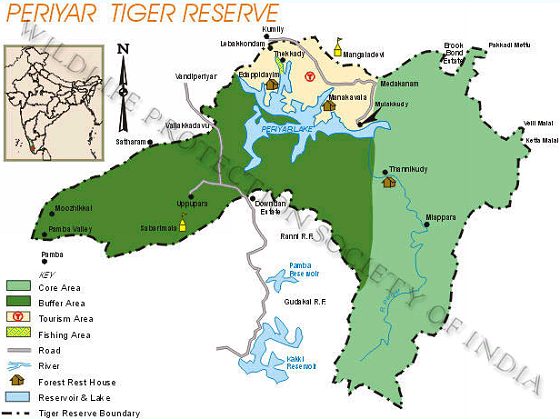Tiger Reserves
| |
|
|

|
|
Periyar
Tiger Reserve
|
|
State
|
Kerala
|
History
|
|
Altitude
(above M.S.L.)
|
100
- 2016 m
|
A
dam was constructed across the periyar river
in 1895. The forest around the new lake
was declared a Reserve Forest in 1899. In
1934 it was established as Nellikkampetty
Sanctuary. This was extended and renamed
Periyar Wildlife Sanctuary in 1950. It became
a Tiger Reserve in 1978, with the core area
declared a National Park in 1982.
|
|
Area
|
Total
|
777
km²
|
|
Core
|
350
km²
|
|
Buffer
|
427
km²
|
|
Fauna
and Flora
|
|
Periyar
Lake is the nucleus of the Tiger Reserve;
It provides water to an extensive area.
1963 species of flowering plants have been
documented, along with a large variety of
animals. Among them are 49 mammal species,
265 bird species, 36 reptile species, 12
amphibian species, 35 fish species and 160
species of butterflies. An estimated 30
tigers are found in Periyar.
|
|
Temperature
|
15°C
- 31°C
|
|
Rainfall
(per annum)
|
2500
mm
|
|
Seasons
|
Winter
|
Dec
- Jan
|
|
Summer
|
Apr
- May
|
|
Monsoon
|
Twice
a year
|
|
Forest
Types
|
|
West
Coast Tropical Evergreen Forests,
West Coast Semi Evergreen Forests,
Moist Deciduous Forest,
Southern Montane Wett Grassland,
Eucalyptus Plantations
|
|
Fauna
|
|
Tiger,
leopard, elephant, gaur, sambar, wild dog,
barking deer, lion-tailed macaque, nilgiri
langur, nilgiri tahr, etc.
|
|
Funds
|
Insufficient
& delayed
|
Management
Objectives
|
|
Staff
|
Untrained
& understaffed
|
Effective
fire-protection measures have promoted natural
regeneration of the grasslands. Planting
of exotic trees has been discontinued and
existing plantations are being converted
back to natural forests. The construction
of water sources is also a priority.
|
|
Problems
|
|
Grazing
and occasional fires are a problem. Poaching
occurs and the inaccessible terrain makes
protection difficult. The main electric
line that runs through the reserve has electrocuted
a number of animals, including 8 elephants.
Ganja cultivation exists in the interior
areas. Trees are felled for this purpose
and people camp illigally in the forest
for the 6 month harvest period, causing
more damage to the environment.
|
|
External
Influences (1991 census)
|
|
Villages
|
58
|
|
Human
population
|
225,000
|
|
Livestock
numbers
|
2,000
|
|
|

|
|